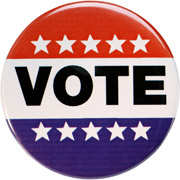ELECTION INSIGHTS 2016
Research-based perspectives from MIT
On Health Care | Andrea Campbell
Arthur and Ruth Sloan Professor of Political Science and Head of the Department of Political Science

"The 2016 election offers voters a stark contrast on health care. Who should get health insurance coverage in the future, and how should it be funded? The stakes are large — both for the nation...and for individuals."
— Andrea Campbell, Arthur and Ruth Sloan Professor of Political Science
ELECTION INSIGHTS 2016
Research-based perspectives from MIT
Question
Health care (including access and affordability) is a major issue in the 2016 election. Based on your research and expertise in this area, what is the most important information or perspective about this issue that would be useful for an American voter to know?
•
American voters face two big health care questions this election season: Who should get insurance and how should it be paid for? The stances of the two major party candidates have very different distributional implications for coverage and funding. The stakes are high as voters contemplate their choices.
The background
Health insurance is enormously expensive — nearly $6,000 on average for an individual, $16,000 for a family according to the Kaiser Family Foundation — and most Americans have it subsidized in some way. The majority of Americans (about 55 percent) get their health insurance through an employer. Many employers pay a portion of the premiums, and neither the premium paid by the employer nor the employee is taxed.
The value of the tax subsidy rises with income, since higher earners pay a higher marginal tax rate (an employee who pays $5,000 per year for her share of her health insurance gets a $500 break if she is a low earner in the 10 percent tax bracket but a $1,750 tax break if she is a high earner in the 35 percent tax bracket).
The public health insurance programs, which cover over one-third of Americans, are also funded by tax revenues but in a more redistributional way. These programs include Medicare for older Americans and the permanently disabled; Medicaid for low-income Americans; and the Children’s Health Insurance Program for children of the working poor. Those getting health insurance through an Affordable Care Act marketplace and who have incomes below 400 percent of the federal poverty level receive a subsidy as well.
All of these programs, except the hospital insurance portion of Medicare, are funded by general tax revenues. Because the U.S. income tax system is progressive, these taxpayer subsidies tend to redistribute from higher income to lower income households. The payroll tax for Medicare hospital insurance used to be flat, but is now progressive as well, due to an increased rate for high earners contained in the ACA.
The question facing voters
The question facing voters is whether they wish to continue this system or to alter the pattern of health insurance coverage and the distributional consequences of the current funding modes. Hillary Clinton has pledged keep the existing system intact while Donald Trump has promised to repeal and replace the Affordable Care Act (ACA). If the Republicans retain control of the Congress as well, there might be a push to change Medicare into a voucher program and to block-grant Medicaid, both long-standing goals of prominent Republican leaders such as House Speaker Paul Ryan.
If the ACA stays in place, it slowly reduces the subsidization of higher earners’ health insurance. Employer-provided insurance is more available to higher income people working for larger employers. Because the income tax system is progressive — with higher earners paying higher marginal income tax rates — the value of the tax subsidy for employer-provided insurance climbs with income as noted. The so-called Cadillac tax in the ACA — an excise tax on the most expensive insurance plans — will over time reduce the size of the tax break on high-end employer plans.

"Turning Medicaid into a block-grant program would have distributional consequences for enrollees, threaten state budgets, and eliminate an important countercyclical fiscal tool. Federal and state governments currently share the cost of Medicaid, which expands automatically to cover those eligible (a number that rises during recessions)."
Which policy do you favor?
The Cadillac tax, combined with the ACA subsidies for people below 400 percent of the poverty line, shifts the public subsidy of health insurance from high earners to lower earners over time. Voters who believe public help for health insurance should go to lower income households rather than higher income households would be on Clinton’s side on this issue.
Trump has pledged to replace the ACA with health savings accounts. Such accounts allow people to put aside money tax-free to purchase health insurance. But as with the tax exemption for employer-based insurance, the biggest breaks go to higher earners. Thus voters who believe more public help should go to higher income households rather than lower income households would be on Donald Trump’s side on this issue.
Impact on seniors
Changing Medicare to a voucher program and block-granting Medicaid would have distributional consequences as well. Under a system of Medicare vouchers, seniors would get a set amount of money — say $8,000 — to purchase health insurance from a private insurer. If the voucher doesn’t cover the premiums for the plan they select, seniors would have to pay the difference. Keep in mind that senior citizens already pay half the cost of their health care out of pocket under the current Medicare system.
Vouchers would allow the federal government to control its outlay for Medicare more easily, but could push more of the cost of health insurance onto seniors, who have lower incomes on average than working-age Americans. And sicker seniors who would need more expensive plans also tend to have lower incomes. Thus turning Medicare into a voucher program could increase costs for lower income seniors.
Impact on state budgets
Turning Medicaid into a block-grant program would have distributional consequences for enrollees, threaten state budgets, and eliminate an important countercyclical fiscal tool. Federal and state governments currently share the cost of Medicaid, which expands automatically to cover those eligible (a number that rises during recessions).
Under a block grant system, each state would instead get a fixed amount of money from the federal government, and that amount would no longer increase automatically during economic downturns, forcing new costs onto state budgets. Because 49 states have balanced budget requirements, they would either have to cut spending in other areas or transform Medicaid from a safety net into a wait-listed program, driving up the number of uninsured.
A stark contrast
Thus the 2016 election offers a stark contrast for voters on health care. Who should get health insurance coverage in the future, and how should it be funded? The stakes are large both for the nation — as health care accounts for one-sixth of economic activity in the United States — and for individuals, as affordable access to health care is an important factor in financial security and quality of life.
Suggested links
ELECTION INSIGHTS 2016
Research-based perspectives from MIT
Andrea Campbell's website
MIT Department of Political Science
News Archive: Caught in the social safety net
Andrea Campbell gives a firsthand perspective on the effects of means-tested social insurance programs.
News Archive: How political science can help us solve global health care issues
MIT political scientist Andrea Campbell discusses the impact of equity on health care innovation and outcomes.
How to Vote in Every State.
See video with info for your state — and vote!
Photograph of Andrea Campbell by Stuart Darsch
